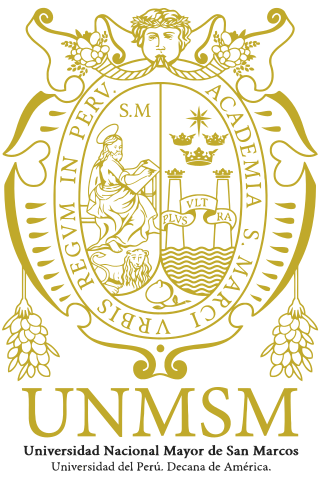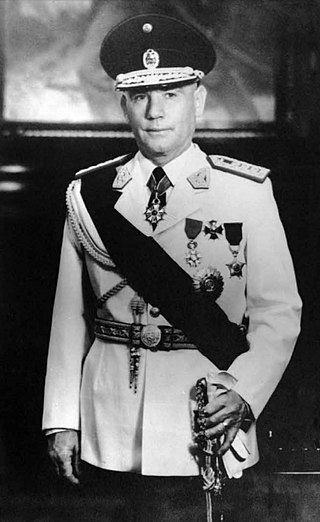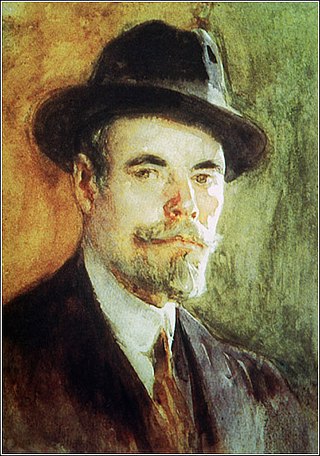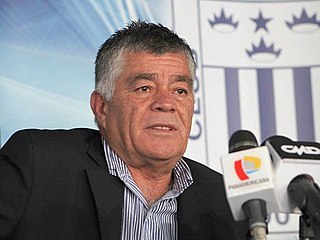
Lima, originally founded as Ciudad de Los Reyes, is the capital and largest city of Peru. It is located in the valleys of the Chillón, Rímac and Lurín Rivers, in the desert zone of the central coastal part of the country, overlooking the Pacific Ocean. Together with the seaside city of Callao, it forms a contiguous urban area known as the Lima Metropolitan Area. With a population of more than 9.7 million in its urban area and more than 11 million in its metropolitan area, Lima is one of the largest cities in the Americas.
Carlos Ernesto Fernando Ferrero Costa is a Peruvian politician who served as congressman as a member of Perú Posible representing Lima from 1995 until 2006 and also served as the President of the Congress from late-2000 until 2003. He was the Prime Minister of Peru from December 2003 until his resignation August 2005. He belongs to the Perú Posible party. Before he became a member of the Perú Posible party, he was part of the Fujimorist Cambio 90 of Alberto Fujimori.

The National University of San Marcos is a public research university located in Lima, the capital of Peru. It is considered the most important, recognized and representative educational institution at the national level. At the continental level, it is the first officially established and the oldest continuously operating university in the Americas, which is why it appears in official documents and publications as "University of Peru, Dean University of the Americas". It had its beginnings in the general studies that were offered in the cloisters of the convent of the Rosario of the order of Santo Domingo —current Basilica and Convent of Santo Domingo— around 1548. Its official foundation was conceived by Fray Thomas de San Martín on May 12, 1551; with the decree of Emperor Carlos I of Spain and V of the Holy Roman Empire, in 1571, it acquired the degree of pontifical granted by Pope Pius V with which it ended up being named as the "Royal and Pontifical University of the City of the Kings of Lima". Being recognized by the Spanish Crown as the first university in America officially founded by Real cédula, it is also referred to as the "University of Lima" throughout the Viceroyalty. Throughout its history, the university had a total of four colleges under tutelage: the Colegio Real y Mayor de San Martín and the Colegio Real y Mayor de San Felipe y San Marcos, the Real Colegio de San Carlos —focused on law and letters, derived from the merger of the two previous ones—and the Royal College of San Fernando—focused on medicine and surgery—. In the times of emancipation, it acquired a main role in the formation of several of the leaders managing the independence of Peru. After the proclamation of independence and during the republic, it maintains both colloquially and formally —in various treaties and documents historical—its name as "University of Lima" until 1946, the year in which its current name and denomination as National and Major University were made official.

Club Universitario de Deportes, popularly known as Universitario or simply as La "U", is a Peruvian football club located in Lima. The club was founded in 1924 under the name Federación Universitaria by students of the National University of San Marcos but was forced to rename in 1931. Since 1928, the club competes in the top tier of Peruvian football, the Torneo Descentralizado. In 2000, they opened the 85,000-capacity stadium Estadio Monumental, currently the largest stadium in Peru and second-largest in South America, retiring their smaller Estadio Teodoro Lolo Fernández. Universitario and Alianza Lima participate in the Peruvian Clásico, which has its roots in the club's first participation in the Primera División in 1928. It also has rivalries with Sporting Cristal, Deportivo Municipal, and Sport Boys.

Nicolás Eduardo Lindley López was a Peruvian military commander who headed the military government in Peru for several months in 1963, and served as the 48th President of Peru.

José Simón Pardo y Barreda was a Peruvian politician who served as the 35th (1904–1908) and 39th (1915–1919) President of Peru.

Daniel Hernández Morillo was a Peruvian painter in the Academic style who spent most of his working life in Paris. He also served as the first Director of the Escuela Nacional de Bellas Artes.
Peruvian art has its origin in the Andean civilizations. These civilizations rose in the territory of modern Peru before the arrival of the Spanish.

Colegio San Andrés is a private school located in Lima, Peru.

Carlos Alejandro Villanueva Martínez was a Peruvian footballer who played for Alianza Lima and the Peru national football team. He is considered one of the most important Alianza strikers in the 1920s and 1930s.

Juan Landázuri Ricketts was one of the most prominent Roman Catholic Churchmen during the 1960s and 1970s in Latin America. This was a period in which the Church took a strong stance against human rights abuses by numerous military juntas; it also expressed a preference for the poor and concerns about extreme poverty and wealth inequality. Before he turned 80 on December 19, 1993, Juan Landázuri Ricketts was the last Cardinal elevated by Pope John XXIII to retain voting rights in a papal conclave.
Rodrigo Antonio Pérez Albornoz is a former Chilean footballer who played as left back. His last professional club was Deportes Iquique.

Mariano Eduardo de Rivero y Ustariz was a prominent Peruvian scientist, geologist, mineralogist, chemist, archaeologist, politician and diplomat. His publications about his discovery of Humboldtine, demonstrating the existence of organic-minerals; about deposits of copper and sodium nitrate (saltpeter) near Tarapacá in the Atacama Desert; about bird-guano and coal in Peru and their possibilities of industrialization as well were forward-looking and made him a pioneer of mining education in South America and the most notable Peruvian scientist of the 19th century.

Jorge Eduardo Eielson was a Peruvian artist and writer. As an artist he is known for his quipus, a reinterpretation of an ancient Andean device, they are considered precursors of conceptual art.
Football is the most popular sport in Peru. Football/soccer in Peru was introduced by British immigrants, Peruvians returning from Great Britain, and by English sailors in the later half of the 19th century during their frequent stops at the port of Callao, which at that point was considered one of the most important ports of the Pacific Ocean. According to the work entitled La Difusión del Fútbol en Lima, during the last decade of the 19th century, records show that sailors were known to practice sports such as football/soccer and played against teams made up of Englishmen, Peruvians, or a mix between Englishmen and Peruvians.
Jorge Piqueras was a Peruvian-born visual artist. He is recognized as one of the most important Peruvian artists of the twentieth century. Among contemporary Latin American artists, he is also a pioneer in geometric painting. Piqueras’ work covers a wide range of materials and media, including sculpture, painting, collage, photography and assemblage.

Oscar Eduardo Valdés Dancuart is a Peruvian businessman and politician who was Prime Minister of Peru from 11 December 2011 until 23 July 2012. A former military officer, he was appointed as Minister of the Interior by President Ollanta Humala on 28 July 2011. Less than five months later, Prime Minister Salomón Lerner Ghitis resigned and Valdés was appointed as his successor on 11 December 2011. He was dismissed on 23 July 2012, after criticism on his handling of the Conga Mining project.
Venancio Shinki was considered one of the most outstanding Peruvian painters. He was born in Supe, Lima, Peru. His father was Japanese and had arrived to Peru in 1915. His mother was Peruvian. He was born and raised on the Hacienda San Nicolás in Supe, north of Lima. At that time, Supe attracted a large concentration of Japanese immigrants. He has 3 children from his first marriage to Keiko Higa.

Miguel Ángel Arrué Padilla is a Chilean football manager and former footballer.

Manuel María Gálvez Egúsquiza was a Peruvian lawyer, magistrate, university professor and politician.












